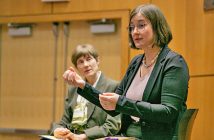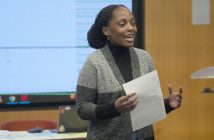Fear not the seekers.
This was the consensus of a panel assembled Dec. 2 at Fordham’s Lincoln Center campus to address the growing number of Americans who are leaving single traditions and instead choosing multiple religious and spiritual sources.
“Spiritual and Religious: What Can Religious Traditions Learn from Spiritual Seekers?” a panel sponsored by Fordham’s Center for Religion and Culture, brought together experts to talk about a group known by demographers as “spiritual but not religious,” or SBNR’s.
Nancy Tatom Ammerman, Ph.D., professor of sociology of religion at Boston University, noted that polling by the Pew Research Center found that, in 2012, 18 percent of American adults identified themselves as SBNR. Two-thirds of those SBNR’s claim an affiliation with some religious tradition and 70 percent believe in God.
“If I had to describe the people who claim to be spiritual, but don’t want to be called religious, I would say that they’re open to a transcendent dimension in their lives, and they’re fairly sure we’re not alone in the universe. But they have very little in their lives that actively connects them to a language for describing that, or with practices that encourage it,” she said.
“They’re lurking around the edges of religious traditions, but they don’t really want to come in the door.”
Story continues below
 Lauren Winner, Peter Phan, Nancy Tatom Ammerman and Serene Jones
Lauren Winner, Peter Phan, Nancy Tatom Ammerman and Serene Jones
Photo by Leo Sorel
Peter Phan, Ph.D., Ignacio Ellacuria Professor of Catholic Social Thought at Georgetown University, called spiritual seekers “trailblazers.”
He argued that being religious today also means being interreligious, and that Christians should learn from doctrinal beliefs, ethical norms, and spiritual practices of other beliefs.
The late Ewert H. Cousins, Ph.D., professor emeritus of theology at Fordham, was correct when he posited that we have entered a second Axial Period, he noted.
The first Axial was a period that saw the establishment of world religions as we know them today, he said. The second one is less about individual consciousness and more about global consciousness.
“In the global consciousness of the Second Axial period, the religions [must]. . . share their treasures and wisdom—not to form a global and undifferentiated super religion, but to enable a richer, more dynamic and complex form of religious consciousness,” he said.
“In many ways, the SBNR’s are paving the way forward with this global consciousness.”
Phan said he found hope when Pope Francis recently wrote: “As Christians, we can also benefit from these treasures built up over many centuries, which can help us better to live our own beliefs.”
“Amazing words,” Phan said. “I would never expect this coming from the pen of any Pope. The spirit, it seems, is flowing in the direction of dialectic dialogue.”
Lauren Winner, Ph.D., assistant professor of Christian spirituality at Duke Divinity School, noted that too much discussion of the “decline of the mainline” church is focused on the upkeep of institutions and physical buildings, and not enough on the connection to God.
“Seekers are a gift to all religious communities, because perhaps what the institutional church in the United States needs more than anything else is a witness to remind the church that people are actually quite hungry for a deep connection to God,” she said.
The discussion was moderated by Serene Jones, Ph.D., president of Union Theological Seminary.


